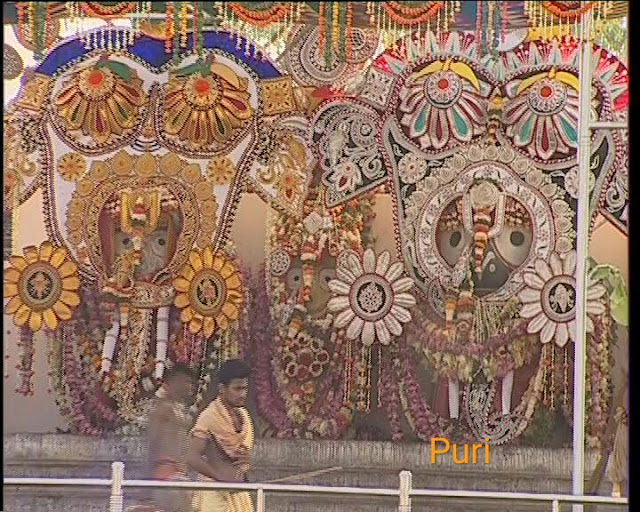ଜଗନ୍ନାଥ: ସ୍ୱାମୀ ନୟନ-ପଥ-ଗାମୀ ଭବତୁ ମେ ।।
जगन्नाथ: स्वामी नयन-पथ-गामी भवतु मे।।
Jagannatha: Swami NayanPath-Gami Bhavatu Me ।।
Introduction
Fig 1
Jagannatha Mahaprabhu (Bhagwan Vishnu’s Avatara), Bhagwan Balabhadra, Devi Maa Subhadra are considered to be the forms and manifestations of the omni-present, omni-scient and omni-potent supreme power. Sudarsana Chakra who is supposed to be the fourth important divine manifestation is also worshipped with the celebrated trio and these four are known as the Chaturddhamurti or the four-fold divine images
We associate Puri Mandira not only with the Devas and Devis presiding therein, but also cultural heritage associated with Shree Kshetra (Shree Mandira (Fig 1) and all other small Mandira’s within the campus) which inspire the Bhakta’s / pilgrims to attain peace of mind. Shree Kshetra has been built in the shape of SHANKHA (which is a conch shell of ritual and religious importance in Hinduism). So, Shree Kshetra is also known as SHANKHA Kshetra. Hence the Jagannatha Dharma has to be understood, interpreted and appreciated with all its social, cultural, religious and spiritual implications
Jagannatha represents an integration of all important Hindu cultures which flourished in India, namely, the Vedic, the Puranic, the Tantric, the Smarta and the Vaisnava. Jagannatha Mahaprabhu is worshipped as Narayan or Vishnu when he is on the Ratnavedi (dias) in the sanctum sanctorum, as Ganesha when on the, Snanavedi during the SnanaPurnima, as Rudra (an expression of Shiva) during the Nava- Kalevara ceremony, as Durga in the Sayana festival and as the Surya Bhagwan when on the Ratha during the Ratha Yatra “Car festival”
Deva Snana Purnima
“Snana gundicha ae swam beni lila jara
Patitapabana arthu prasadu bahara”
Fig 2
Deva Snana Purnima is an auspicious bath ceremony of Jagannatha Mahaprabhu which is celebrated on the Purnima i.e. full moon day of Hindu Calendar month Jyestha to memorialize appearance of Chaturddhamurti (Jagannatha Mahaprabhu, Bhagwan Balabhadra, Devi Maa Subhadra and Sudarsana Chakra). As per Skanda Purana, Raja Indradyumna arranged for this bathing ceremony on Purnima day of Jyestha month and since then it has been celebrated as Deva Snana Purnima (Fig. 2) since centuries. This auspicious festival is not limited to Shree Mandira but is celebrated at all Jagannatha Mandira’s all over India and world
On the previous day of Snana Yatra (as it also known as) MURTIS of Jagannatha Mahaprabhu, Bhagwan Balabhadra, Devi Maa Subhadra and Sudarsana Chakra are ceremonially brought out in a procession to the Snana-vedi (Snana Mandap) which is situated near the northern gate of Shree Mandira. The Snana Mandap has been brilliantly built so that Bhakta’s of Jagannatha Mahaprabhu even standing in Shree Kshetra can easily see the Chaturddhamurti’s
Chaturddhamurti’s are bathed by 108 gold vessels (Jagannatha Mahaprabhu – 35, Bhagwan Balabhadra – 33, Devi Maa Subhadra –22 and Sudarsana Chakra – 18) filled up with water brought from Suna Kua ‘the Golden Well’ situated inside Shree Mandira. This Vidhi “Ritual” is known as JALABHISHEK (JALA - water, Abhishek - bath). The filled vessels are carried by the Suaras / Daitapatis in a long single-line procession. This Vidhi is called 'JALADHIBASA'
After JALABHISHEK, Jagannatha Mahaprabhu and Bhagwan Balabhadra are dressed like Bhagwan Ganesha with head of elephant and Devi Maa Subhadra wears Lotus Flower as MUKUTA. Jagannatha Mahaprabhu's and Bhagwan Balabhadra's Besha is known as GAJANANA Besha and Devi Maa Subhadra's Besha is known as Kumari Besha (Padma Besha) (Fig. 3)
Fig 3
As per ITIHASA, it is believed one of the renowned scholars and also a loyal Bhakta of Bhagwan Ganesha visited Puri centuries ago. Respecting his knowledge the then King of Kalinga rewarded him for his scholarship and requested him to visit Shree Keshtra to pray to Jagannatha Mahaprabhu. The scholar refused to visit citing the reason he wouldn’t worship any form of Bhagwan other than Ganesha. But the King of Kalinga however persuaded him and brought him to Snana Mandapa. Jagannatha Mahaprabhu appeared in form of Bhagwan Ganesha and since, then after the JALABHISHEK Vidhhi “Ritual” the divinities are dressed in the form of GAJANANA Besha
This costume is offered by Gopaltirtha Matha & Raghavdas Matha. This besha is especially dedicated to the famous Gananpati Bhatta
Some glimpses of Deva Snana Purnima as celebrated in various cities (Fig 4, 5, 6, 7, 8, 9, 10)
Fig 4
Fig 5
Fig 6
Fig 7
Fig 8
Fig 9
Fig 10
After the JALABHISHEK, Chaturddhamurti’s are kept away from their Bhakta’s for 15 days in Ratna Vedi (sickroom) situated inside the Shree Mandira. This short period is also known as “Anabasara Kala” and Shree Mandira remains closed
During this Anabasar Kala Bhakta’s visit Alarnath Thakur “Avatara of Shri Krishna” at Brahmagiri in Puri District. As per ITIHASA, it is believed that Jagannatha Mahaprabhu had advised his Bhakta’s for this short period he will give Darshan to them in the Avatara of Alarnath Thakur (Fig 11, 12, 13, 14)
Fig 11
Fig 12
Fig 13
Fig 14
On the 16th Day Chaturddhamurti’s become ready for darshan to the Bhakta’s on Navajaubana Darshan. Netrotsava is also observed on that day and next day onwards RATHA YATRA festival begins. To know about RATHA YATRA please read this detailed article written by this author in Rightlog.in
ନୀଳାଦ୍ରୌ ଶଙ୍ଖମଧ୍ୟେ ଶତଦଳକମଳେ ରତ୍ନସିଂହାସନସ୍ଥ˚ ।
ସର୍ବାଳଙ୍କାରଯୁକ୍ତ˚ ନବଘନରୁଚିର˚ ସଂଯୁତ˚ ଚାଗ୍ରଜେନ ।।
ଭଦ୍ରାୟା ବାମଭାଗେ ରଥଚରଣଯୁତଂ ବ୍ରହ୍ମ୍ରରୁଦ୍ର˚ଦ୍ର ବନ୍ଦ୍ୟ˚।
ବେଦାନା˚ ସାରମୀଶଂ ସ୍ଵଜନପରିବୃତ˚ ବ୍ରହ୍ମଦାରୁ˚ ଭଜେଽହମ୍ ।।
This article could not have been possible without the significant inputs and generosity of my parents
References/Sources:
- Utkal Prasanga (Monthly Odia Magazine published by Odisha Govt.)
- Odia newspaper - Prameya
- http://jagannath.nic.in/?q=home
- www.orissa.gov.in
- http://rathjatra.nic.in/about.htm
- http://www.nabakalebara.gov.in/
- http://www.rathyatra.org/devasnana-purnima.html
- OTV News
- http://www.nabakalebara.gov.in/newsDetails/In-News/134
- Images














Comments
Post a Comment